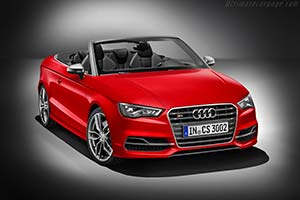
| Audi S3 Cabriolet |
| Article | Image gallery (20) | Specifications |

|
|
<< Prev Page 2 of 3 Next >> The turbocharged 2.0 TFSI, which displaces 1,984 cc (bore x stroke 82.5 x 92.8 millimeters), is a true sports engine. Heavy-duty aluminum pistons and higher-strength connecting rods transmit the forces to the crankshaft. The aluminum-silicon alloy used for the cylinder head combines high thermal stability and strength with minimal weight. Two balance shafts ensure supremely smooth running performance. With its dynamic character, the four-cylinder offers up a fascinating driving experience. When the standard Audi drive select dynamic driving system is operating in dynamic mode, it has a heightened throttle response, and the engine revs up briefly when the S tronic shifts gears. The sound flaps in the exhaust system open as the load and rpms increase. The turbocharger provides charging pressures of up to 1.2 bars, and a powerful intercooler greatly reduces the temperature of the compressed air. The so-called drumble (swirl and tumble) flaps direct incoming air in a targeted manner. The camshaft can be offset by 60 degrees relative to the crankshaft on the intake side and by 30 degrees on the exhaust side. In addition, the Audi valvelift system (AVS) regulates the valve lift in two stages. In the NEDC cycle, the Audi S3 Cabriolet with S tronic requires just 7.1 liters of fuel per 100 kilometers (33.13 US mpg) (165 grams of CO2 per kilometer [265.54 g/mile]). The technologies from the Audi modular efficiency platform contribute to this impressive figure. Of particular interest here is the additional indirect injection into the intake manifold, which replaces the gasoline direct injection FSI in the part-load range, where it lowers fuel consumption and particulate emissions. And the 2.0 TFSI is also at the leading edge in terms of thermal management. Two rotary valves combined in one module regulate the flow and temperature of the coolant. The exhaust manifold is integrated in the cylinder head where coolant is circulating; this solution reduces the temperature of the exhaust gases, which improves fuel economy at full load. An additional advantage is faster warming of the engine during cold starting. And the friction-lowering coating of the piston skirts, the rolling bearings in the balance shafts, the on-demand oil pump and the start-stop system all do their part to improve efficiency. In the standard six-speed S tronic transmission, the bottom gears are close-stepped for a sporty effect, whereas the long gear ratio of the top gear lowers rpms and therefore fuel consumption. The driver can operate the lightning-fast dual-clutch transmission in the automatic D and S modes or take control using the gearshift lever in the touch control gate or the optional paddles on the steering wheel. An attractive efficiency function of the six-speed S tronic is the one-way clutch. It becomes active when Audi drive select is in efficiency mode and the driver steps off the accelerator. During a starting maneuver at full throttle from a standstill, Launch Control, another feature of the dual-clutch transmission, ensures that the power of the engine is transmitted to the road with a defined tire slip. Typical of the S model line: Of course, the S3 Cabriolet also makes use of quattro permanent all-wheel drive - the perfect foundation for optimal traction and driving dynamics in all road conditions. Only Audi offers permanent all-wheel drive in a compact-class convertible car. Its characteristic strength lies in the enhanced slip-free acceleration, driving dynamics, driving safety and directional stability that it delivers. The powerful compact car is dynamic and stable at any speed, even in difficult winter conditions. When exiting a corner, it securely transmits its power to the road, while its two-wheel-drive competitors have to struggle for grip. The centerpiece of the quattro drive for the Audi models with transversely mounted engines is the redesigned electronically controlled hydraulic multi-plate clutch. The compact, robust clutch is located at the end of the prop shaft, in front of the rear axle differential, where it contributes to the balanced axle distribution despite its relatively low weight. Inside is a package of plates that rotate in an oil bath. The metal friction rings are arranged behind one another in pairs - one ring of each pair is rigidly meshed with the housing, which rotates with the prop shaft. The other ring is meshed with the output shaft to the rear axle differential. In normal conditions, the clutch sends most of the engine's power to the front wheels. If traction decreases there, the clutch can transfer torque continuously to the rear axle by forcing the packages of plates together via controlled action. << Prev Page 2 of 3 Next >> |
| Article | Image gallery (20) | Specifications |
| All Cars - Contact us - Privacy Statement - Top | © 1998 - 2024 Ultimatecarpage.com |

